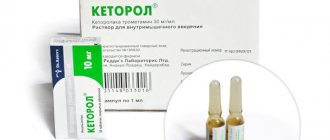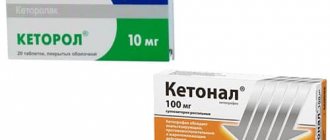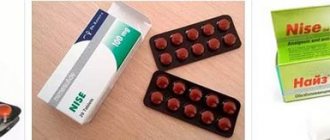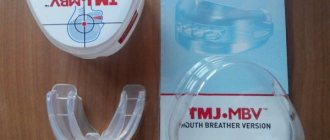Ketorol®
The frequency of side effects is classified depending on the frequency of occurrence: often - (1-10%), sometimes (0.1-1%), rarely (0.01-0.1%), very rarely (less than 0.01% ), including individual messages.
From the digestive system: often (especially in elderly patients over 65 years of age with a history of erosive and ulcerative lesions of the gastrointestinal tract) - gastralgia, diarrhea; less often - stomatitis, flatulence, constipation, vomiting, feeling of fullness in the stomach; rarely - nausea, erosive and ulcerative lesions of the gastrointestinal tract (including with perforation and/or bleeding - abdominal pain, spasm or burning in the epigastric region, melena, vomiting like “coffee grounds”, nausea, heartburn and others), cholestatic jaundice, hepatitis, hepatomegaly, acute pancreatitis.
From the urinary system: rarely - acute renal failure, lower back pain with or without hematuria and/or azotemia, hemolytic-uremic syndrome (hemolytic anemia, renal failure, thrombocytopenia, purpura), frequent urination, increased or decreased urine volume, nephritis, edema of renal origin.
From the senses: rarely - hearing loss, ringing in the ears, visual impairment (including blurred visual perception).
From the respiratory system: rarely - bronchospasm, shortness of breath, rhinitis, laryngeal edema.
From the central nervous system: often - headache, dizziness, drowsiness, rarely - aseptic meningitis (fever, severe headache, convulsions, stiffness of the neck and/or back muscles), hyperactivity (mood changes, anxiety), hallucinations, depression, psychosis .
From the cardiovascular system: less often - increased blood pressure, rarely - pulmonary edema, fainting.
From the hematopoietic organs: rarely - anemia, eosinophilia, leukopenia.
From the hemostasis system: rarely - bleeding from a postoperative wound, nosebleeds, rectal bleeding.
From the skin: less often - skin rash (including maculopapular rash), purpura, rarely - exfoliative dermatitis (fever with or without chills, redness, thickening or peeling of the skin, swelling and/or tenderness of the tonsils), urticaria, Stevens syndrome - Johnson, Lyell's syndrome.
Allergic reactions: rarely - anaphylaxis or anaphylactoid reactions (change in facial skin color, skin rash, urticaria, itching of the skin, tachypnea or dyspnea, swelling of the eyelids, periorbital edema, shortness of breath, difficulty breathing, heaviness in the chest, wheezing).
Other: often - swelling (face, legs, ankles, fingers, feet, weight gain); less often - increased sweating, rarely - swelling of the tongue, fever.
Ketorol
NSAIDs have a pronounced analgesic effect, have anti-inflammatory and moderate antipyretic effects. The mechanism of action is associated with non-selective inhibition of COX activity (COX-1 and COX-2), which catalyzes the formation of prostaglandins from arachidonic acid, which play an important role in the pathogenesis of pain, inflammation and fever. Ketorolac is a racemic mixture of [-]S- and [+]R-enantiomers, with the analgesic effect due to the [-]S-form. The strength of the analgesic effect is comparable to morphine, significantly superior to other NSAIDs.
The drug does not affect opioid receptors, does not depress respiration, does not cause drug dependence, and does not have a sedative or anxiolytic effect.
After oral administration, the analgesic effect develops within 1 hour.
Pharmacokinetics
Suction
When taken orally, ketorolac is well and quickly absorbed from the gastrointestinal tract. The bioavailability of ketorolac is 80-100%, Cmax after oral administration at a dose of 10 mg is 0.82-1.46 mcg/ml, Tmax is 10-78 minutes. Food rich in fat reduces the Cmax of the drug in the blood and delays its achievement by an hour.
Distribution
Plasma protein binding is 99%, Vd is 0.15-0.33 l/kg. The time to reach Css when taken orally at a dose of 10 mg 4 times a day is 24 hours, Css is 0.39-0.79 mcg/ml.
Excreted in breast milk: when taking ketorolac at a dose of 10 mg, Cmax in breast milk is achieved 2 hours after taking the first dose and is 7.3 ng/ml, 2 hours after taking the second dose of ketorolac (when using the drug 4 times a day) – 7.9 ng/l.
Metabolism
More than 50% of the administered dose is metabolized in the liver with the formation of pharmacologically inactive metabolites. The main metabolites are glucuronides and p-hydroxyketorolac.
Removal
Excreted mainly by the kidneys - 91%, through the intestines - 6%, glucuronides are excreted in the urine. Not excreted by hemodialysis.
T1/2 in patients with normal renal function averages 5.3 hours (2.4-9 hours after oral administration at a dose of 10 mg). When administered orally at a dose of 10 mg, the total clearance is 0.025 l/h/kg.
Pharmacokinetics in special groups of patients
T1/2 increases in elderly patients and shortens in young ones.
Impaired liver function does not affect T1/2.
In patients with renal failure, the Vd of the drug may increase by 2 times, and the Vd of its R-enantiomer by 20%. In patients with impaired renal function with a plasma creatinine concentration of 19-50 mg/l (168-442 µmol/l), T1/2 is 10.3-10.8 hours, with severe renal failure - more than 13.6 hours. In patients with renal failure (with plasma creatinine concentrations are 19-50 mg/l) total clearance is 0.016 l/h/kg.
Non-steroidal anti-inflammatory drug Ketorol in the treatment of pain syndromes
A drug with a mechanism of action that suppresses the activity of both forms of COX (COX-1 and COX-2) is ketorolac (international nonproprietary name), trade name Ketorol® (Dr. REDDY'S Laboratoris Ltd.). The active substance of the drug is ketorolac tromethamine [3, 4], which is a racemic mixture of (-)S- and (+)R-enantiomers, and the analgesic effect is due to the (-)S-form. The drug is rapidly absorbed, has high bioavailability (80–100%), binds to plasma proteins by 90–99%, undergoes hepatic metabolism, and is excreted by the kidneys (90%) and intestines (6%). After oral administration of 10 mg, the effect develops after 10–60 minutes, after intramuscular administration of 30 mg - after 15 minutes. The duration of action of the drug is 6–10 hours. However, due to the high risk of complications typical of NSAIDs, the period of its recommended use is limited to 5 days. In this mode, as studies have shown, the intensity of pain syndrome is reduced by 66% by the 3rd day of treatment, and by 82% by the 5th day [1, 5]. The therapeutic potential of ketorolac has been proven for all areas of urgent analgesia; in monotherapy, its effect is comparable to small doses of “hard” opioids [6]. In terms of analgesia, it is superior to other NSAIDs and is among the first-line drugs for short-term treatment of severe pain [7, 8]. The drug does not act on opioid receptors, therefore it does not cause adverse reactions from the central nervous system, respiratory depression and smooth muscle paresis, drug dependence, and does not have a sedative or anxiolytic effect [3, 4]. The significant analgesic effect of ketorolac is emphasized, comparable to the effect of narcotic analgesics [9], with a significantly lower incidence of serious adverse drug reactions, which together significantly reduces the cost of pharmacotherapy. Release forms: 1) tablets for oral administration of 10 mg, 2) solution for parenteral administration in ampoules of 30 mg / 1 ml, 3) 2% Ketorol gel for topical use (contains 20 mg of active substance). Indication for use is pain of severe and moderate severity (intended for symptomatic therapy, reducing the intensity of pain and inflammation at the time of use; does not affect the progression of the disease) of various origins and localization: trauma, toothache, pain in the postpartum and postoperative period, pain syndrome for oncological diseases, myalgia, arthralgia, neuralgia, radiculitis, dislocations, sprains, rheumatic diseases. When applied topically, Ketorol gel causes a weakening or disappearance of pain at the site of its application, incl. pain in the joints at rest and during movement, reduces morning stiffness and swelling of the joints [3, 4]. The drug Ketorol gel should be prescribed with caution to elderly people and pregnant women (I and II trimesters). Studies on the use of ketorolac in urgent conditions The results of a prospective multicenter study conducted in 49 clinics in 8 European countries showed [10] that ketorolac is highly effective in relieving acute pain syndromes after surgery (orthopedic, abdominal, gynecological, urological, plastic surgery) . A comparative analysis of the effectiveness and safety of ketorolac with diclofenac and ketoprofen included the results of treatment of 11,245 patients. It was found that the incidence of adverse drug reactions when taking ketorolac (90 mg/day for 2 days parenterally, then 40 mg/day for 7 days) did not differ in comparison with that when using diclofenac (150 mg/day for 2 days parenterally, then 150 mg/day for 7 days). mg/day for 7 days) or ketoprofen (200 mg/day for 2 days parenterally, then 200 mg/day for 7 days). At the same time, the risk of developing gastrointestinal bleeding and allergic reactions was significantly lower in patients taking ketorolac compared to the comparison group (diclofenac, ketoprofen). The Department of Surgery at the University of British Columbia Hospital (Vancouver, Canada) conducted a multicenter, double-blind, randomized study to compare the rate and extent of the onset of analgesic effect and the patient's functional status with a single IV dose of ketorolac and dose titration of meperidine, as well as the occurrence of adverse events [11] . This study looked at patients aged 18–65 years with moderate to severe renal colic. They were divided into 2 groups, comparable by gender and age, race and other parameters. Patients in the meperidine group received 50 mg IV at time zero, then 25–50 mg every 15 minutes. to relieve ongoing pain. Patients in the ketorolac group received 30 mg IV at time zero and placebo injections every 15 minutes. as needed. The level of pain and adverse events were assessed every 15 minutes, functional status - after 60 minutes. The main criterion for the effectiveness of the drug was the reduction of pain to moderate or its disappearance after 60 minutes. Adequate pain relief was experienced by 72% of patients receiving ketorolac and 64% of patients receiving meperidine; 44% of patients receiving ketorolac and 10% of patients receiving meperidine were able to resume normal activities after 60 minutes. The authors concluded that single IV administration of ketorolac at study doses for the relief of acute renal colic is equally effective as IV titration of meperidine and causes less functional impairment. Thus, ketorolac has been shown to be an effective drug for the treatment of renal colic, does not require close patient monitoring and does not cause adverse sedation. A comparative study conducted at the Department of Head and Neck Surgery at Loyola University Hospital (Maywood, USA) [12] assessed the efficacy and safety (risk of bleeding) of intravenous ketorolac 30 mg postoperatively in patients undergoing primary endoscopic surgery. paranasal sinuses (septum surgery), compared with the effectiveness and safety of 25 mcg fentanyl. The level of postoperative pain was recorded at 0, 30 and 60 minutes. on a visual analogue scale (VAS). Patients received fentanyl and hydrocodone/acetaminophen as needed (if pain was not sufficiently relieved). Questionnaires assessing postoperative bleeding were completed on the 1st and 7th postoperative days. 34 patients were observed, of which 16 received IV ketorolac, 18 received fentanyl. There were no significant differences in the groups when assessing pre- and postoperative hemoglobin levels, the appearance of bleeding, the severity of pain according to VAS, or the number of doses of additional analgesics. Thus, ketorolac administered intravenously was a safe analgesic during endoscopic surgery of the paranasal sinuses, because There was no increased risk of bleeding or acute posthemorrhagic anemia. The analgesic effect of IV administration of ketorolac is comparable to the effect of IV administration of fentanyl. Another study, conducted in the Department of Urology at Howard University Hospital (Washington, USA), assessed the degree of analgesic effect of 60 mg ketorolac administered intravenously during outpatient transrectal ultrasound examination and prostate biopsy [13]. The prospective study involved 24 patients who were randomized into 2 groups: Group 1 received 60 mg of ketorolac intravenously before the procedure, Group 2 (control) received no anesthesia. The number of biopsies performed, in which patients were able to withstand the entire procedure, was significantly lower in the control group than in the group that received IV ketorolac. In contrast, pain levels in patients receiving IV ketorolac were significantly lower than in patients without pain relief. Thus, intravenous administration of ketorolac significantly reduces pain during a painful procedure in full and allows patients to tolerate it more easily. Application of Ketorol in dental surgery E.A. Bazikian et al. (2005) conducted a comparative study to evaluate the effectiveness of the drug Ketorol in relieving pain in 30 patients (15–59 years) [14]. To relieve pain, Ketorol was prescribed 30 minutes in advance. before surgery IM in a single dose of 30 mg. In the following days (if necessary), Ketorol was prescribed per os at a dose of 10 mg. The daily dose did not exceed 40 mg. The total duration of use of Ketorol was determined by the need to relieve pain by the patients themselves and did not exceed 2 days (in patients undergoing implantation, Ketorol was used once 30 minutes before surgery). Thus, the studies have shown that Ketorol provides fairly reliable and adequate pain relief in the postoperative period. The authors concluded that Ketorol is safe when prescribed for prophylactic purposes (i.e., before pain syndrome), promoting a painless course of the postoperative period, and recommend including it as a permanent component of premedication. O.A. Egorova (2009) conducted a study to evaluate the effectiveness of Ketorol in relieving pain after dental surgery in outpatient practice [15]. The study included 40 patients (19–50 years old) who were treated in a dental surgery office. The first dose of Ketorol (10 mg) was immediately after surgery (against the background of the action of the anesthetic). The maximum intensity of the pain syndrome was recorded 1–2 hours after the operation; no increase in the intensity of the pain syndrome was observed while taking Ketorol. In case of pain syndrome, patients were recommended to continue taking Ketorol at a dose of 10 mg, but not more than 40 mg/day. The average daily dose of the drug was 20 mg. The course of taking Ketorol among those observed did not exceed 2 days. Thus, this study demonstrated the effectiveness of Ketorol as a powerful analgesic during a short course of use in patients after dental surgery and demonstrated its safety. A.A. Timofeev et al. (2012) provided a comparative description of non-narcotic analgesics – ketorolac and dexketoprofen, used in maxillofacial surgery for postoperative pain relief for patients [6]. 155 patients were examined: Group I (n=72) – after maxillofacial surgical interventions (removal of osteoblastomas and jaw cysts); Group II (n=40) – with open fractures of the body of the lower jaw; Group III (n=43) – with inflammatory diseases of the soft tissues of the maxillofacial region and neck (abscesses and phlegmon in patients with drug addiction). On the 1st day after surgery, ketorolac was prescribed intramuscularly at 10–20 mg every 8 hours (3 times a day), on the 2nd–3rd day – 10–20 mg every 12 hours (2 times a day). ), and on days 4–5 – 10 mg 2 times a day. On the 1st day after the operation, in patients of group I (n=27), severe pain (6–7 points) was observed in 46.8% of cases, moderate pain (4–5 points) – in 53.2%; on the 5th day, postoperative pain of low intensity was noted in 42.6%, pain was absent in 57.4% of cases. In group II, ketorolac was prescribed (n=20) according to the following regimen: in the first 2 days – 10–20 mg p/o or intramuscularly every 8 hours (3 times/day), on days 3–5 – p/o o 10 mg every 12 hours (2 times/day). After 30–45 min. after the first dose, a significant decrease in pain response was observed. In group III, ketorolac was prescribed (n=22) according to the following regimen: in the first 2–3 days of treatment intramuscularly, from the 3rd–4th day - po, on the 4th day after opening the purulent-inflammatory focus no pain was noted . Patients taking ketorolac had a more pronounced and prolonged analgesic effect compared to dexketoprofen, and the least number of side effects. Thus, ketorolac can be recommended for use in the postoperative period after removal of tumor-like and tumor formations of the jaws, for fractures of the lower jaw, after opening abscesses and phlegmons in patients burdened with drug addiction [6]. Ketorolac in the treatment of diseases of the musculoskeletal system The main goal of the treatment of acute nonspecific pain in the lumbosacral spine is, first of all, pain relief. Therapy is focused on drugs from the NSAID group with the most effective risk/benefit ratio, of which the sequential use of Ketorol and Nise currently deserves special attention. A pain relief regimen was proposed: if necessary, prolong therapy, switching to Nise 200 mg/day, 7–10 days is possible (Fig. 1) [1]. E.A. Galushko et al. (2008) conducted an open, controlled, randomized comparative study with similar forms of diclofenac sodium [16]. An assessment was made of the clinical effectiveness and tolerability of 2 dosage forms of Ketorol (tablets and solution for injection) in patients with osteoarthritis (OA) of the knee joint with severe pain. The study included 109 patients: the main group consisted of 51 patients with gonarthrosis, of which 25 received the tablet form of Ketorol (10 mg 2 times a day), 26 received the injection form (1 ml - 30 mg once); The control group consisted of 58 patients who received diclofenac (50 mg 2 times a day or 3 ml - 75 mg once). An assessment of the short-term effectiveness of the therapy showed that Ketorol is not only not inferior to diclofenac in the effectiveness of pain suppression in OA, but also exceeds it in the severity of pain relief by 25–30%. Good effectiveness (according to doctors) was noted already in the first 3 days of using Ketorol and was detected in more than half of the patients, while when using diclofenac - in 17% of those receiving tablets and in 36% of those receiving injections. In 9.8% of cases, adverse events were noted: dyspepsia and epigastric pain, and in 1.9% - an allergic reaction. To assess the safety of the drug, the levels of liver enzymes (ALT, AST), creatinine and hemoglobin in the blood were determined in all patients. The indicators were assessed during the initial examination and 5 days after starting Ketorol. The levels of the above laboratory parameters did not change significantly and remained normal throughout the study, which indirectly indicates the absence of side effects of the drug on kidney, liver and blood function. The presented results indicate the high analgesic effectiveness of Ketorol for gonarthrosis [16]. According to data provided by A. Garkavi et al. (2009), when relieving acute pain syndrome in patients with pathology of the musculoskeletal system in the early post-traumatic and postoperative periods, the effectiveness of Ketorol on the 1st day is not inferior to the effectiveness of tramadol, which is accompanied by fewer side effects [17]. ON THE. Szostak et al. (2006) provide data that the administration of Ketorol to patients with various pathologies in the clinic of internal medicine made it possible to completely relieve pain in 20% of patients, significantly reduce the severity of pain in 55% and reduce the severity of pain in 25% [5] . Based on the data obtained, the authors classified Ketorol as one of the effective and safe drugs used in the complex treatment of diseases of internal organs (pleuropneumonia, chronic non-calculous cholecystitis, urolithiasis, etc.) complicated by pain. According to the data given in the article by V.V. Skvortsova et al. (2011), after intramuscular administration of ketorolac, the maximum concentration in the blood plasma is achieved after 15–60 minutes. [18]. The drug is administered in a dose of 10–30 mg every 4–6 hours, depending on the severity of the pain syndrome. Ketorolac should be prescribed at the minimum effective dose. The maximum daily dose for adult patients under 65 years of age should not exceed 90 mg, for patients over 65 years of age or with impaired renal function - 60 mg. The maximum duration of parenteral use of the drug is 5 days. When transferring a patient from parenteral administration to oral administration, the total daily dose of ketorolac in both dosage forms on the day of transfer should not exceed 90 mg for patients under 65 years of age and 60 mg for patients over 65 years of age or with impaired renal function. In this case, the dose of the drug in tablets on the day of transition should not be more than 30 mg. Orally, 10 mg is prescribed every 4–6 hours (no more than 4 tablets/day, the maximum daily dose should not exceed 40 mg). Ketorolac in the outpatient practice of G.I. Bragina et al. (2006) in outpatient practice studied the effectiveness and safety of Ketorol in patients with acute pain syndrome of various origins [19]. The study was conducted in clinics No. 37, 56, 102 of the Moscow Department of Health and in clinic No. 3 of the Central Clinical Hospital of the Russian Academy of Sciences. 95 patients were observed (mean age: 54.6±10.6 years). The pain syndrome in patients was caused by arthropathy, dorsopathies, spondylopathy, soft tissue lesions, injuries of the musculoskeletal system, etc. In 36% of patients, preceding therapy with analgesics or NSAIDs, the effect of which was absent or insignificant. Patients were divided into 2 groups: I group (n = 52) received ketorol, II group (n = 43) - ketoprofen. The duration of therapy was 5 days. A comparative assessment of the intensity of pain according to your (0–100) against the background of taking drugs: before treatment, after 15, 30 minutes, 2, 6 hours. During the study, a change in the intensity of pain against the background of ketorol intake was obtained - 83.8 ± 11, 6 points (before treatment) VS 39.8 ± 20.8 points (after 6 hours), ketoprofen - 81.0 ± 10.8 points (before treatment) VS 46.7 ± 14.0 points (after 6 hours). Over the next 5 days, the regression of the pain syndrome was noted, and when using ketorol, a positive effect is achieved with a dynamically decreasing daily dose of the drug substance. When taking ketorol in 7.5% of cases, undesirable side effects were noted: discomfort and pain in the epigastric region, dizziness, difficulty in urination. Thus, the clinical efficiency and safety of ketorol in a dosage of 30 mg/day were demonstrated in the treatment of patients with acute pain for 5 days, which allows us to recommend this drug for wide use in outpatiental-linenic practice in patients with acute pain syndrome [19] . In the study by A.L. Vertkina et al. (2004) Assessment of comparative painkillers and safety of ketorolac and metamizole sodium in pain at the prehospital stage [20]. The study included 445 patients (the average age - 51 ± 4.9 years), which were divided into 2 groups: Ketorolak group (n = 220) and a group of sodium metamizole (n = 225). The severity of the pain syndrome is estimated by your (0–100), and patients also noted the level of pain intensity in 20 minutes. After a single in/m introduction of ketorolac at a dose of 30 mg. In the course of the study, the following results were obtained: 1) the analgesic efficiency of ketorolac (according to yours) is 2.6 times higher than that of the sodium metamizole; 2) the pain completely disappeared in 12.7% of cases after taking ketorolac and only in 2% after taking sodium metamizole; 3) the introduction of ketorolak was effective in all cases, in the group of metamizole sodium in 5.3% there was no effect. The frequency of development of side effects (most often dyspeptic symptoms) when using ketorolac was 2.7%. Thus, ketorolac provides high efficiency, rapid and prolonged anesthesia, and low risk of side effects. Not being an accounting drug, ketorolax can be recommended for use as an analgesic of the first row at the prehospital stage in an ambulance [20]. A.L. Vertkin et al. (2006), as part of the program of the National Scientific and Practical Society for the Emergency Medical Assistance, the first comparative open multicenter controlled clinical study of the efficiency and safety of the parenteral use at the pre-capital stage of NSAIDs (sodium, sodium diclofenac, ketorolac and loroxicam) was carried out with various origin of various origin [7 , 8]. The study included 1011 patients (average age - 54.1 ± 0.46 years). At the prehospital stage, they introduced a 2 ml of a 50% solution of in/m of metamizol sodium (n = 240), 3 ml - 75 mg of V/m of diclofenac (n = 153), or 30 mg/1 ml in/m ketorolac (n = 318 ), or 8 mg/2 ml in/m loroxicam (n = 95). From the study, 54.7% took part in urgent help in connection with skeletal-muscular pain, 24.1% for injury, 21.2% with renal colic. According to the criteria, your better efficiency was possessed by Loroxics and ketorolac, according to the results of the assessment of the dynamics of pain, ketorolalacts surpasses sodium metamizol by 1.3 times. In the course of the study, it was revealed: 1) by the number of repeated calls, the drugs are located as follows: metamizole> diclofenac> ketorolala = Loroxes; 2. min.; 3) according to the speed of the onset of a distinct painkillers, the drugs were distributed as follows: Loroxics = Ketorolak> Diclofenac> Metamizole; 4) by the strength of analgesic effect on injury, the studied drugs can be arranged as follows: ketorolala> Loroxics> Diclofenac = metamizole. The average difference in the intensity of the pain that occurred in connection with the injury before and after treatment for yours in the Metamizole group was 58.9 ± 3.0 points, diclofenac - 60.0 ± 4.6 points, ketorolac - 77.8 ± 1.9 score, loroxicam - 68.0 ± 4.7 points. According to this indicator, Ketorolakus was superior in analgesic activity to the Loroxes and the rest of the analgesics. Among the unwanted phenomena when using ketorolac in 9.4% of cases, dyspepsia was noted, in 2.9% - urticaria. Thus, the presented results indicate the feasibility of using ketorolac at the prehospital stage of the treatment of acute pain, while this drug is the most effective in injury and acute skeletal-muscle pain in comparison with other analgesics and NSAIDs [7, 8]. A.L. Vertkin et al. (2011) Assessment of the effectiveness and safety of the use of NSAIDs to stop the pain syndrome in the practice of the doctor on duty in a multidisciplinary hospital [21]. The study included 627 patients (average age - 56.7 ± 6.3 years) with pain syndrome, which were in a stationary treatment in a multidisciplinary hospital (compartment of therapy, general surgery, neurology) of ambulance). A metamizole of sodium + pythofenon + Fenpianius bromide at a dose of 5.0 ml iv, diclofenac - 75 mg iv, ketorolax - 10 mg iv, paracetamol - 500 mg iv droppings was prescribed. In assessing the effectiveness of reducing ketorolac pain, it turned out to be the most effective in patients in therapeutic departments, surgical practice. Assessing the analgesic potential of drugs in all departments, the authors note the greatest effectiveness of ketorolac. The most rapidly anesthetic effect was felt by the patients who were prescribed by ketorolac (48.7 minutes). After 12 hours, patients evaluated the quality of anesthesia on a 5-point scale and O-the average score 4.6. Thus, it is concluded that by the subjective assessment of the effectiveness of pain relief in your best drug for emergency anesthesia, ketorolac is. In terms of efficiency/safety ratio, the advantage in choosing pain relief in the practice of the doctor on duty of a multidisciplinary hospital also in ketorolac. In addition, the adequate relief of the painful syndrome is an important additional factor in the stabilization of blood pressure in patients with a hypertensive crisis [21]. The use of ketorolac in the treatment of cervicogenic headaches Effective therapy of cervicogenic headaches (CGB) is possible with a complex approach and joint use of pharmacological and non -drug methods, including blockades with local anesthetics. Medical blockades with local anesthetics temporarily reduce the intensity of pain and reliably increase the effect of drug therapy. In the treatment of CGB, drugs of various groups are used: NSAIDs, muscle relaxants, antidepressants, anticonvulsants [22]. At the same time, according to most experts, it is more preferable to use NSAIDs (ketorolak, diclofenac, nimesulide). The use of NSAIDs is possible both for stopping acute pain and as part of complex therapy for chronic CGB. It is advisable to prescribe drugs with a pronounced anti -inflammatory and analgesic effect, given the accompanying somatic pathology. In neurological practice, the use of Ketorolak is recommended in the treatment of the Central City Hospital for no more than 5 days in the form of in/m injections at a dose of up to 90 mg/day or in a tablet form of 20–40 mg/day [22]. The conclusion of the studies demonstrated the clinical efficiency and safety of the drug ketorolac in the form of in/m injections at a dose of up to 90 mg/day or in a tablet form of 20–40 mg/day (an average of 30 mg/day) for no more than 5 days in treatment Patients with acute pain syndrome [23]. According to the instructions for the new form of use of the drug, Ketorol Gel is applied 3-4 r/day (no more), the duration of use is up to 10 days [4]. The analgesic activity of Ketorolak exceeds such analgesics. The safety of the drug is confirmed on the basis of laboratory tests. Thus, the need for the widespread use of ketorolac (ketorola) in outpatient and voglinical practice is shown in patients with acute pain, at the prehospital stage in an ambulance as an analgesic of the first row, in the provision of ambulance, in the provision of ambulance with urgent conditions.
Literature 1. Alekseev V.V. Stepped NSAID therapy for acute pain in the lumbosacral region // Effective pharmacotherapy in neurology and psychiatry. 2010. No. 4. pp. 22–28. 2. Erokhin A.I., Voronkova V.V., Kuzin A.V. The effectiveness of Ketorol for pain syndrome at an outpatient dental appointment. URL: https://www.ketorol.ru. 3. Ketorolac: instructions for use. URL: https://www.rlsnet.ru/tn_index_id_1720.htm. 4. Ketorol: instructions for use. URL: https://www.ketorol.ru. 5. Shostak N.A., Pravdyuk N.G., Egorova V.A. Back pain in the elderly - approaches to diagnosis and treatment // Clinician. 2011. No. 3. pp. 72–77. 6. Timofeev A.A., Ushko N.A., Dakal A.V. and others. Comparative characteristics of non-narcotic analgesics used in maxillofacial surgery // Practitioner dentist. 2012. No. 2. P. 48–51. 7. Vertkin A.L., Topolyansky A.V., Vovk E.I. and others. The place of Ketorolac in the treatment of acute pain syndromes at the prehospital stage // Emergency Doctor. 2006. No. 6. P. 1–6. 8. Vertkin A.L., Topolyansky A.V., Vovk E.I. and others. The place of Ketorolac in the treatment of acute pain syndromes at the prehospital stage // Consilium medicum. 2006. T. 8. No. 2. P. 86–90. 9. Jelinek GA Ketorolac versus morphine for severe pain. Ketorolac is more effective, cheaper, and has fewer side effects // Br Med J. 2000. Vol. 321. R. 1236–1237. 10. Forrest JB, Camu F, Greer IA et al. Ketorolac, diclofenac, and ketoprofen are equally safe for pain relief after major surgery // Br J Anaesth. 2002. Vol. 88(2). R. 227–233. 11. Wood VM, Christenson JM, Innes GD et al. The NARC (nonsteroidal anti-inflammatory in renal colic) trial. Single-dose intravenous ketorolac versus titrated intravenous meperidine in acute renal colic: a randomized clinical trial // CJEM. 2000. Vol. 2 (2). R. 83–89. 12. Moeller C., Pawlowski J., Pappas AL et al. The safety and efficacy of intravenous ketorolac in patients undergoing primary endoscopic sinus surgery: a randomized, double-blinded clinical trial // Int Forum Allergy Rhinol. 2012. Vol. 2 (4). R. 342–347. 13. Mireku-Boateng AO Intravenous ketorolac significantly reduces the pain of office transrectal ultrasound and prostate biopsies // Urol Int. 2004. Vol. 73(2). R. 123–124. 14. Bazikyan E.A., Ignatovich V.V. Evaluation of the effectiveness of Ketorol and Nise in the clinical practice of surgical dentistry // Dentistry. 2005. T. 84. No. 3. P. 49–50. 15. Egorova O.A. Efficacy and safety of Ketorol for pain syndrome in an outpatient surgical dentistry clinic // Dentistry. 2009. No. 6. pp. 53–54. 16. Galushko E.A., Zotkin E.G., Salikhov I.G. and others. Clinical effectiveness and tolerability of various NSAIDs for osteoarthritis with severe pain // Attending physician. 2008. No. 4. pp. 82–84. 17. Garkavi A., Silin L., Semevsky A. Relief of acute pain syndrome in patients with pathology of the musculoskeletal system in the early post-traumatic and postoperative periods // Doctor. 2006. No. 13. pp. 40–44. 18. Skvortsov V.V., Tumarenko A.V., Odintsov V.V. and others. Current issues in the diagnosis and treatment of glenohumeral periarthritis // Polyclinic. 2011. No. 2. P. 56–58. 19. Bragina G.I., Vinogradova L.A., Gorshkova Yu.M. and others. Pain syndrome in outpatient practice: Ketorol // Bulletin of Family Medicine. 2006. No. 2. P. 44–47. 20. Vertkin A.L., Prokhorovich E.A., Goruleva E.A. and others. Efficacy and safety of using Ketorol for pain relief at the prehospital stage // Emergency Therapy. 2004. No. 1–2. pp. 16–17. 21. Vertkin A.L., Shamuilova M.M., Naumov A.V. Assessing the effectiveness and safety of the use of non-steroidal anti-inflammatory drugs for pain relief in the practice of an on-duty doctor in a multidisciplinary hospital // Drug supply and pharmacoeconomics. 2011. No. 5. pp. 76–84. 22. Tabeeva G.R. Cervicogenic headache: pathophysiology, clinical picture, approaches to therapy // Neurology, neuropsychiatry, psychosomatics. 2010. No. 2. pp. 19–26. 23. Shavlovskaya O.A. Clinical efficacy and tolerability of Ketorolac in the treatment of pain syndromes // Consilium medicum. 2013. T. 15. No. 2. P. 34–37.











